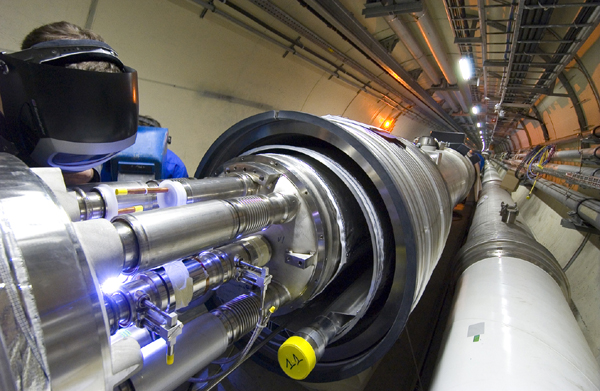GENEVA, Sept 22 (Reuters) - An international team of
scientists said on Thursday they had recorded sub-atomic
particles travelling faster than light -- a finding that could
overturn one of Einstein's long-accepted fundamental laws of the
universe.
Antonio Ereditato, spokesman for the
researchers, told Reuters that measurements taken over three years
showed neutrinos pumped from CERN near Geneva to Gran Sasso in Italy had arrived 60 nanoseconds quicker than light would have done.
"We have high confidence in our results. We have checked and
rechecked for anything that could have distorted our
measurements but we found nothing," he said. "We now want
colleagues to check them independently."
If confirmed, the discovery would undermine Albert
Einstein's 1905 theory of special relativity, which says that
the speed of light is a "cosmic constant" and that nothing in
the universe can travel faster.
That assertion, which has withstood over a century of
testing, is one of the key elements of the so-called Standard
Model of physics, which attempts to describe the way the
universe and everything in it works.
The totally unexpected finding emerged from research by a
physicists working on an experiment dubbed OPERA run jointly by
the CERN particle research centre near Geneva and the Gran Sasso
Laboratory in central Italy.
A total of 15,000 beams of neutrinos -- tiny particles that
pervade the cosmos -- were fired over a period of 3 years from
CERN towards Gran Sasso 730 (500 miles) km away, where they were
picked up by giant detectors.
Light would have covered the distance in around 2.4
thousandths of a second, but the neutrinos took 60 nanoseconds
-- or 60 billionths of a second -- less than light beams would
have taken.
"It is a tiny difference," said Ereditato, who also works at
Berne University in Switzerland, "but conceptually it is
incredibly important. The finding is so startling that, for the
moment, everybody should be very prudent."
Ereditato declined to speculate on what it might mean if
other physicists, who will be officially informed of the
discovery at a meeting in CERN on Friday, found that OPERA's
measurements were correct.
"I just don't want to think of the implications," he told
Reuters. "We are scientists and work with what we know."
Much science-fiction literature is based on the idea that,
if the light-speed barrier can be overcome, time travel might
theoretically become possible.
The existence of the neutrino, an elementary sub-atomic
particle with a tiny amount of mass created in radioactive decay
or in nuclear reactions such as those in the Sun, was first
confirmed in 1934, but it still mystifies researchers.
It can pass through most matter undetected, even over long
distances, and without being affected. Millions pass through the
human body every day, scientists say.
To reach Gran Sasso, the neutrinos pushed out from a special
installation at CERN -- also home to the Large Hadron Collider
probing the origins of the universe -- have to pass through
water, air and rock.
The underground Italian laboratory, some 120 km (75 miles)
to the south of Rome, is the largest of its type in the world
for particle physics and cosmic research.
Around 750 scientists from 22 different countries work
there, attracted by the possibility of staging experiments in
its three massive halls, protected from cosmic rays by some
1,400 metres (4,200 feet) of rock overhead.
(Reporting by Robert Evans; Editing by Tom Miles and Kevin
Liffey)
news from http://www.reuters.com/article/2011/09/22/science-light-idUSL5E7KM4CW20110922

No comments:
Post a Comment